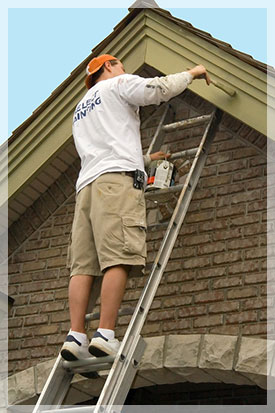Never Paint Your Home in These 3 Weather Conditions
 When a homeowner requests house painting services for the exterior, one question that frequently comes up is, “Is it the right time of year for a fresh coat of paint?”
When a homeowner requests house painting services for the exterior, one question that frequently comes up is, “Is it the right time of year for a fresh coat of paint?”
While there’s no perfect instance, certain conditions are ideal for priming and adding two coats to a surface. On a very general level, this ideal range tends to be between 50°F to 90°F – so, a good deal of the year for those in New England – and not too sunny, too wet, or too windy.
That being said, there are a handful of exceptions. Some acrylic paint formulas allow you to apply a coat in temperatures down to 35°, or a bright day with lots of sun in winter is far better for getting the job done (or, at least part of it) before the dark and wet conditions set in.
However, not painting in desirable weather ends up having long-term consequences. Specifically, the job simply doesn’t last as long, with cracks forming sooner. For your home’s exterior, this reduces any barrier the paint creates – not to mention, it starts to give the property a worn appearance.
Yet, a few conditions should be avoided whenever painting a wall, deck, or fence in the outdoors:
The Cold
According to The Paint Quarterly Institute, most latex paints shouldn’t be applied when the air temperature gets below 35°F to 50°F.
There are a few reasons for this:
- The paint takes longer to dry.
- Wet paint, as a result, is more vulnerable to collecting dirt, insects and pollen
- Multiple coatings can’t easily be applied. Because the paint doesn’t dry soon enough between coats, blistering and bubbling result.
Visually, you’ll notice a change. The surface isn’t even; rather, streaks or spots of dark paint appear, or the surfactant leaches onto the paint.
In some cases, a skilled painter can cut it close in colder conditions while still producing a clean job:
- An acrylic latex formula, which lets you paint in temperatures down to 35°F, is used.
- You know the moisture content of the substrate.
- You set aside a period in which the sun is expected to be out for a few hours.
On Wet Surfaces
Dirt, debris, pollution, and mildew all accumulate onto your home’s surface. As a result, a painting job begins by washing and cleaning: this may be as simple as scrubbing or, for more intense jobs, power-washing.
Yet, even on a warm, mild day, the surface still must be dry. As a result, painting in the rain is never recommended.
But even moisture can disrupt how paint dries. Specifically, when it comes to applying acrylic paint to stucco, moisture and a high alkalinity pH result in saponification. As you apply the paint, you’ll start to see streaks or a spotty appearance.
In Hot Conditions
As a contrast, weather that’s too hot or has too much sun isn’t ideal for painting, either.
What can happen? The opposite – the paint dries too quickly, especially when latex paints are used.
As a result, if you do decide to paint your house in the summer, take the following conditions into account:
- The air and surface temperatures should not exceed 90°F.
- Don’t paint in direct sunlight – start in the shade or use a covering.
- Avoid days with too much wind.
New England’s weather makes adding a fresh coat of paint or finish to your home’s exterior a possibility. If you’re considering revitalizing its appearance or adding a protective coating, contact M. Brett Painting for a free consultation.
